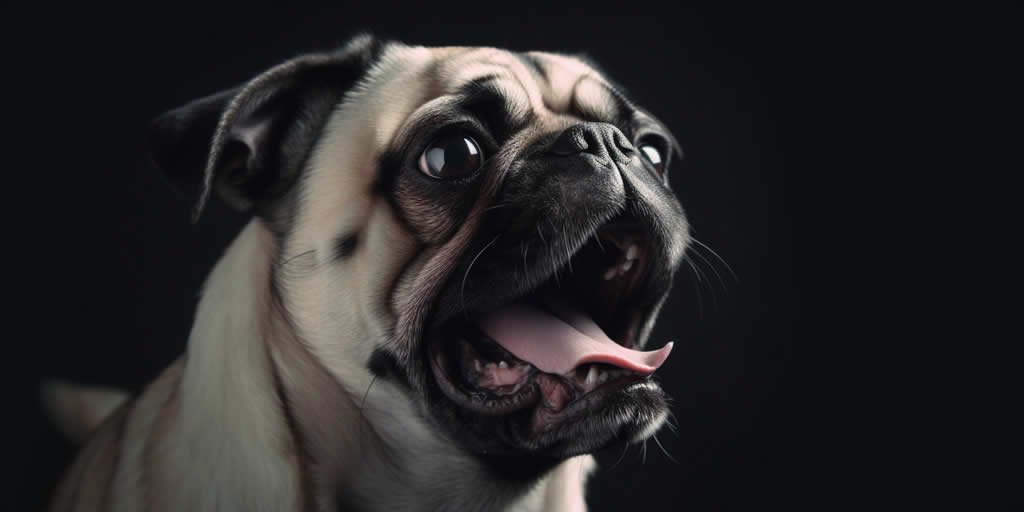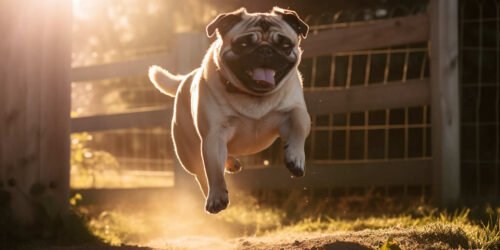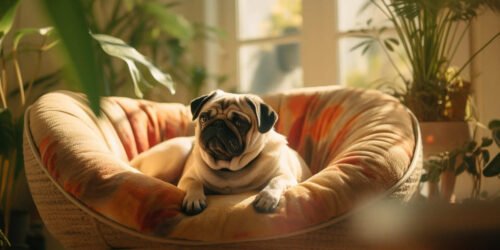Do Pugs Scream?
Introduction
Have you ever heard loud, high-pitched noises coming from your pug and wondered whether it was a scream, or something else? Do Pugs Scream? It’s a common question among Pug owners – luckily, the answer is yes.
Pugs are small but vocal dogs with expressive personalities. They may bark as most other dogs do, but many times these emotional outbursts start sounding more like screams.

These behavioral sounds often come in response to pain, fear and anxiety being experienced by the pup. Whether you are considering getting a Pug or already have one at home, this article will provide an understanding of what causes them to scream and how to cope with this behavior.
Table of Contents
- Introduction
- Understanding Pug Behavior: What Is Pug Screaming?
- Why Do Pugs Scream And What Are The Triggers?
- Coping With Pug Screaming
- Living With A Screaming Pug: Tips For Pet Owners
- Conclusion
Key Takeaways
- Pugs are expressive animals with vocal outbursts often mistaken as screams due to their intensity.
- Separation anxiety, attention seeking behavior, fear and anxiety, and medical issues can all trigger Pug screaming.
- Proper prevention methods including providing enrichment activities throughout the day along with positive reinforcement training can help curb pug screaming behaviors.
- Regular vet checkups should be conducted in order diagnose any underlying health issues that could potentially be causing the screaming behavior.
Understanding Pug Behavior: What Is Pug Screaming?
Pug screaming is a type of vocalization that pugs make in response to various stimuli. It’s usually distinguishable from other noises, such as barks, yips or whines, and can often sound like a short cry or howl.
While not usually indicative of pain or distress, pugs may scream when they experience excitement in the form of joyous tears due to the sheer happiness associated with moments such as mealtime treats and their favorite toys.
In other cases however, this behavior could be seen as an indication of frustration due to being trapped in uncomfortable situations while trying to escape predators; hunger since they need food every few hours; fear associated with loud noises/fast movements; separation anxiety caused by concerns over loneliness when left alone at home; attention-seeking behaviors built out of boredom; medical issues leading up to neck pain accompanied by excessive barking/screaming, among others.
In order for pet owners seeking any beloved four-legged companion (in this case especially – the Pug) to understand if there are triggers related specifically affecting your pup’s potential wails and roars better – proper attentive care must be taken into account upon adopting one so that everyone involved knows what might expected whenever.
Why Do Pugs Scream And What Are The Triggers?
Pugs can scream for a variety of reasons, including fear and anxiety, attention-seeking behavior, medical issues and their fight or flight response.
Separation Anxiety
Separation anxiety is the main cause of Pug screaming and it usually happens when the dog is left alone or separated from their owners. This behavior normally develops because Pugs form a strong bond with their humans and become anxious when apart.
Signs of separation anxiety in dogs include excessive barking, whining and howling as well as destructive behaviors such as chewing furniture, digging at carpets, scraping windows/doors to get out etc. In extreme cases, these anxious behaviors may result in self-injuries due to stress.
It’s important for pet owners to understand that this type of anxiety doesn’t happen overnight – it takes time for dogs (especially certain breeds like Pugs) to adjust if they have been moved from home environments or adopted into new families abruptly without proper introduction.
To reduce separation anxiety issues, pet owners should try engaging their pug in activities during daily walks and playtime going outdoors together before leaving them on their own will help build trust between both parties over time and gradually reduce fear-related responses whenever they are away from each other.
Attention-Seeking Behavior
Attention-seeking behaviors are common among dogs, including pugs. These actions can be signs of confusion or frustration, and they usually happen when an animal is seeking attention from their humans.
Pugs in particular may exhibit attention-seeking behavior through vocalizing while they’re alone or interacting with family members; this behavior usually involves yawning and sighing as well as “screaming” and barking.
Pugs have natural expressive tendencies which can manifest into various forms of nonverbal communication, one example being hunger cues such as whining when a meal is being prepared.
Likewise, excitement around people or other animals may also cause them to vocalize more frequently than usual. For some pets these reactions may become excessive over time if not adequately managed by providing enriching activities throughout the day that will help keep their minds active and engaged.
Fear And Anxiety
Pugs have a strong connection with their owners and can feel separation anxiety when left alone. Separation Anxiety is characterized by this fear of being away from their guardians and can often manifest itself in behaviors such as barking, chewing, or screaming.
Fear and anxiety are at the heart of many causes for pug screaming. Noises that may be unfamiliar like construction noise or thunderstorms can cause dogs to become scared or uncertain, crying out as if they’re in danger.
Pugs tend to develop phobias over time due to associations they make after frequent exposure to certain triggers – loud noises may worsen a pre-existing fear your pup has while leaving them unattended could bring on new fears altogether.
That said, it’s important to identify your pet’s triggers so you can take steps towards preventing or mitigating bouts of anxiety.
The key here is providing enrichment activities throughout the day which keep them occupied during periods where they would normally be unsupervised or feeling anxious; exercise stimulating toys, dog walks around the neighborhood (or even better – somewhere new) will help bring focus back onto their owner while helping reduce stress levels that come paired with being apart from them.
Medical Issues
As a pug owner, it’s important to understand the health issues that can cause your pup to scream. Medical problems such as pain, breathing difficulties, and brachycephalic airway obstruction syndrome (BAOS) are all potential triggers for screaming in pugs.
A common health concern in pugs is their constricted nose and small nostrils – this condition is known as brachycephaly which can lead to respiratory difficulties and an inability to cool down.
This can trigger panic or shouting from the dog due to discomfort or distress. Additionally, many owners will report separation anxiety issues or other types of behavior problems caused by boredom in their pug – these situations may also be accompanied by excessive vocalizations because the animal does not want its family far away from them.
Taking precautions against these conditions helps keep your Pug healthy and relaxed which ultimately decreases instances of extreme barking or shrieking outbursts.
Common Triggers For Pug Screaming
Pugs are known for their sweet dispositions and outlook on life, but they can sometimes let out a loud scream. While this behavior is normal and not cause for alarm, it’s important to know the common triggers associated with Pug screaming in order to properly manage the behavior.
First and foremost, separation anxiety is very common among Pugs when being separated from their owners or primary guardian. This can lead to vocalization such as barking or howling that needs to be addressed through proper training techniques designed specifically for dogs who exhibit these behaviors. In addition, Pugs may scream due to pain caused by medical conditions so it’s always best practice for pet owners of any breed of dog to have routine check-ups performed by a veterinarian in order diagnose any underlying health issues that could potentially be causing the screaming behavior.
Excitement at being presented with their favorite toy or food is another very common trigger for Pug screaming as these little characters get overly enthusiastic when faced with something they love! Fear in dogs can also manifest itself vocally – if your pug becomes scared while out on a walk you will likely hear them express this emotion loudly; similarly if there are loud noises like thunderstorms taking place near where you live then your Pug may also scream during these instances too. Sadness has been known to cause crying sounds from some dogs – though unknown why exactly this happens – some veterinarians believe sad cries come about because dogs cannot vocalize more complex emotions such as sadness like humans do so instead emit louder sounds than usual that we take as those described above types of screams/cries/whimpers depending upon level of intensity from situation happening around them .
Finally, happiness can bring about excitement which often leads commonly signs pup’s joyfulness including excitable shouting and other related vocalizations! It’s important therefore assess situations prior engaging with animal ensure they’re comfortable before providing anything might possibly cause an outbreak joyful (or fearful) commotion—not just long-term issues aimed managing behavioral responses but short-term incidents continue improve communication between pet owner over time.. By understanding potential causes and triggers associated with Pug Screaming, pet owners will be better equipped at managing any unwanted noise coming from Fido!
Coping With Pug Screaming
Understanding the triggers behind screaming is key to preempting it and decreasing its intensity.
Tips For Calming A Screaming Pug
Pugs may scream due to variety of different triggers, including being startled, afraid, excited, or in pain. It’s important that pet owners do not reward this behavior with attention as this will only reinforce it. Instead, pet owners can use a combination of calming techniques to sooth the pug and eventually discourage them from screaming.
- Create a Calm Environment: Providing a safe and comfortable space for your pug to relax is essential for curtailing screaming behavior. Ensure their crate or den isn’t too small or cluttered with items that might startle them, and provide comfortable bedding in a quiet area of the house.
- Gentle Cuddles: Petting your pug and holding them gently can help calm them down when they are feeling overwhelmed or anxious. Provide skin-to-skin contact as much as possible, as this will create feelings of safety and security for your pug which should reduce their anxiety related screaming behaviors.
- Discipline Appropriately: When pugs scream, they are simply trying to get an emotional response from humans and it’s important not to scold harshly or excessively punish the behavior; instead use positive reinforcement by rewarding good behaviors with treats or verbal praise when they stop the behaviour that you don’t want them exhibiting (i.e screaming).
- Positive Reinforcement Training: Using positive reinforcement training methods is one of the most effective ways to train a dog out of unwanted behavior – including screams! Reinforce anything that moves away from unwanted behavior with a small treat or pat on the head – this will help strengthen desired behaviors while reducing others over time if consistently enforced.
- Provide Adequate Exercise & Mental Stimulation: Making sure your pug gets plenty of exercise and mental stimulation throughout each day will help keep them active and entertained which should curb their tendency towards unwanted vocalization like screams! Take frequent walks together, set up fun agility courses (or find an agility class), hide toys around the house for your pup to discover and play stimulated games like “find it” for further mental excitement!
- Seek Professional Help: If all else fails then it might be worth seeking professional help from an animal behaviorist who can advise on how best to reduce screaming episodes and provide tools for managing future outbreaks more effectively
Preventative Measures
One of the best ways to keep your pug from screaming is by taking some preventative measures. Here are a few tips that pet owners can use to help stop their pup’s undesired vocalizations:
- Provide plenty of exercise and mental stimulation. This will help channel an animal’s energy into more constructive activities than just screaming for attention.
- Ensure that your home provides a safe and comfortable environment for your dog, free from loud noises or other triggers that may cause distress.
- Practice positive reinforcement training with your pup on a regular basis to build a trustful relationship between you and your furry companion.
- Seek professional advice if necessary; Your veterinarian or canine behavior specialist may be able to provide insight into why exactly your pug is engaging in this type of behavior and suggest appropriate remedies specific to the situation at hand.
- Maintain consistency; Keeping routine schedule will ensure stability within the household where pets feel safe and secure, leading them towards better emotional regulation and fewer bouts of hysteria induced screaming sessions.
Positive Reinforcement Training
Positive reinforcement training is a popular and effective approach for training Pugs. This type of reward-based training uses praises, petting, treats, or toys to reward good behavior in dogs and reinforce desired behaviors.
With consistent positive reinforcement, you can successfully teach your Pug basic obedience skills such as potty training and basic commands like sit, stay, come and heel.
An important aspect of using positive reinforcement with Pugs is understanding anxiety-related vocalization — also known as Pug screaming! If a Pug screams excessively it could be due to separation anxiety or fear/anxiety issues caused by repeated negative experiences in their life.
In such cases utilizing positive reinforcement techniques can help promote calm behaviours allowing them to cope better with these emotional outbursts.
Seeking Professional Help
When dealing with a Pug’s excessive or uncontrollable screaming, it is advisable to get help from a professional dog trainer or behaviorist. Consulting an expert can lead to better coping mechanisms for managing the behavior and getting control over the situation.
Professional help also provides pet owners with valuable insights into understanding pug behavior and what triggers their vocalizations in certain contexts. For example, separation anxiety could be one of the main reasons behind your pup’s screaming episodes, so consulting a professional would provide effective strategies on how best to ease this issue.
In addition, speaking with experts yields helpful advice on training techniques catered specifically towards your individual Pug’s needs – offering guidance through the implementation of preventative measures that discourage unwanted behaviors such as screaming while simultaneously encouraging desired behaviors like being calm when left alone or staying quiet during mealstime! Furthermore receiving practical advice from professionals helps build relationships between owner and pet based upon trust and consistency – making it easier for both parties to find balance within home life where everyone feels safe ,happy ,and completely comfortable .
Living With A Screaming Pug: Tips For Pet Owners
To live with a Pug successfully, pet owners should understand the reasons behind their dog’s behavior and maintain patience and consistency when providing training and reinforcement.
Additionally, it is important to provide regular physical activity as well as mental stimulation for Pugs in order to help keep them calm and content.
Understanding The Behavior
When it comes to understanding why Pugs scream, it can be helpful to consider their natural behavior and body language. As highly expressive dogs, Pugs often use vocalizations like screaming or yipping as a way of communicating with humans.
This behavior can have different underlying meanings depending on context and the emotion behind the sound. Commonly, Pug owners may interpret Pug screaming as an attention-seeking action that occurs when their pup’s desires are not immediately met or out of frustration or excitement.
Anxiety or fear might also cause your Pug to scream if they encounter something unexpected in the environment that is frightening; likewise, medical issues such as pain could contribute to loud vocalizations coming from your four-legged friend.
To help identify what may be triggering this behavior in particular circumstances, pet owners should observe how their pug reacts in surroundings where they previously were peaceful.
Maintaining Patience And Consistency
Living with a screaming pug can be frustrating, but it is crucial to keep calm and maintain your patience when training your pet. It is important to remain consistent in all of your interactions with the pup – providing rules and boundaries, offering rewards for good behavior, correcting bad behavior calmly yet firmly, and reassuring them when they are distressed.
Positive reinforcement training practices are particularly effective— encouragement goes a long way! Rewarding desired behaviors with verbal praise or small treats (such as their favorite toy) while ignoring undesirable ones will quickly reinforce better habits in an enjoyable way.
Providing Adequate Exercise And Mental Stimulation
As Pug owners, it is our responsibility to help keep pugs active and engaged by providing them with sufficient exercise and mental stimulation. Without this attention, Pugs may develop excess energy that can lead to destructive behavior such as screaming.
The typical rule of thumb for Pug exercise is 5 minutes of formal exercise for each month of their age.
Playing outside isn’t the only key to keeping your pup happy though – They thrive off physical engagement as much as mental. Purchasing interactive toys that can flex their minds like Kongs challenge dogs physically by making them work out treat puzzles while still curbing boredom rather than stuffing their faces due to lack of activity! Treats can always be used in training sessions too; rewards should never replace appropriate social interaction between you and your dog.
Creating A Safe And Comfortable Environment
Taking care of a pet pug is not just about providing regular meals – it is also important to give them the right environment in which they can thrive.
To create a suitable environment for your pug, start by making sure their diet contains the right nutrients including protein, healthy fats and carbohydrates. Exercise is equally important – taking daily walks with your pup in the park allows them to burn off excess energy while giving them an opportunity to interact with other people and dogs.
This socializing time strengthens behavioral bonds which help keep them from feeling stressed or lonely when left on their own during times of separation anxiety.
You should also provide plenty of positive reinforcement and rewards every time your pup displays desired behaviors such as sitting, walking politely on-leash etc., but avoid using harsh punishment since this may only cause further disruption in their behavior.
Additionally, offering mental stimulation toys like puzzle feeders will help keep their mind engaged so that there are less moments where boredom leads to undesirable outcomes like inappropriate chewing or screaming fits.
Conclusion
Pug screaming can be an alarming problem for owners given its loud pitch, but it is important to remember that Pug behavior should not be judged too harshly. Pugs are expressive animals and their screams often occur due to separation anxiety or when they want attention from their humans.
It’s essential that owners remain patient and understand the causes of the screaming before attempting any sort of training or discipline. Taking precautions such as having a consistent schedule, providing plenty of exercise and mental stimulation, or even seeking professional help from a dog trainer may all be helpful in dealing with this issue.






